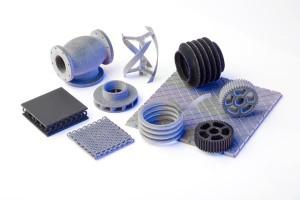The biggest obstacle to widespread adoption of 3D printers as a manufacturing tool, as well as a tool for the home, has been the speeds at which objects gradually materialize. No company will directly print out a product  when it takes them hours to do so, and hobbyists often shy away from the technology, claiming that they don’t have the patience.
when it takes them hours to do so, and hobbyists often shy away from the technology, claiming that they don’t have the patience.
In what is being described as a major 3D printing breakthrough, researchers at the Universities of Sheffield and Loughborough created the FACTUM 3D printer. The printer uses what they are calling high speed sintering technology (HSS). Currently the FACTUM printer is using plastic polymer materials in the form of powder, but eventually could broaden its scope of material options. Instead of using an extruder like many polymer based 3d printers do to slowly melt the plastic into a layer that is placed methodically in a given pattern, or using a laser to sinter metals as they are deposited, FACTUM uses a sweeping heat lamp to sinter larger areas of the material at a lower temperature. The ironic part is that the lamp applies heat to the material 10,000 times longer than a laser does, yet the print process is exponentially faster.
In a test, the printer could print out entire finger sized polymer objects in under a second. A typical fused deposition modeling printer like a Makerbot Replicator would easily take 30 minutes to an hour to do the same job.
British printing company Xaar teamed with the researchers to developed special inkjet technology for the FACTUM 3D printer, and it is one of the key technologies that allows this printer to work at such amazing speeds. In addition, both Unilever and BAE Systems have teamed up to explore possible applications for the technology.
“The fact that it has attracted the interest of the likes of Unilever and BAE Systems underscores this potential,” said David Chapman, the developer of Xaar’s inkjet system. “Inkjet is at the heart of this technology and by working with our supply chain partners, Xaar is committed to bring this technology to market.”
This technology is sure to drive more companies towards 3D printing, and if commercialized for hobbyists, it could really push the technology quickly into the mainstream.
“We can imagine lots of applications where products are currently made in CNC machining out of aluminium because the part is made in small quantities and moulding it is cost prohibitive, so the choice is to machine it and this dictates that the material should be metal. If you are going to use HSS and you don’t have to consider the cost of tooling, you don’t have to consider machining – therefore the part doesn’t have to be metal. So we see a lot of opportunities particularly in low production up to a few thousand where we think these technologies will displace the CNC machining market,” said University of Sheffield’s Professor Neil Hopkinson, of the Department of Mechanical Engineering, who was on the research team that invented HSS.
Specific details are still limited on this new printer, but they are certain to emerge over the coming weeks and months ahead. Head over to the FACTUM forum thread to discuss this technology and share new information as it becomes available to the public. [Source – tctMagazine]
Subscribe to Our Email Newsletter
Stay up-to-date on all the latest news from the 3D printing industry and receive information and offers from third party vendors.
Print Services
Upload your 3D Models and get them printed quickly and efficiently.
You May Also Like
3D Printing News Briefs, July 2, 2025: Copper Alloys, Defense Manufacturing, & More
We’re starting off with metals in today’s 3D Printing News Briefs, as Farsoon has unveiled a large-scale AM solution for copper alloys, and Meltio used its wire-laser metal solution to...
3DPOD 260: John Hart on VulcanForms, MIT, Desktop Metal and More
John Hart is a Professor at MIT; he´s also the director of the Laboratory for Manufacturing and Productivity as well as the director of the Center for Advanced Production Technologies....
3D Printing News Briefs, June 28, 2025: Defense Accelerator, Surgical Models, & More
In this weekend’s 3D Printing News Briefs, 3YOURMIND was selected to join an EU Defense Accelerator, and PTC has announced model-based definition (MBD) capabilities within Onshape. Finally, a study out...
EOS in India: AM’s Rising Star
EOS is doubling down on India. With a growing base of aerospace startups, new government policies, and a massive engineering workforce, India is quickly becoming one of the most important...


































